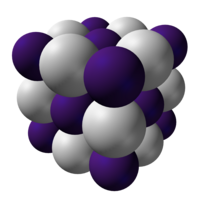Caesium hydride
 Caesium cation,Cs+ Hydrogen anion,H− | |
| Names | |
|---|---|
| IUPAC name
Caesium hydride
| |
| Other names
Cesium hydride
| |
| Identifiers | |
3D model (JSmol)
|
|
| ChemSpider | |
PubChemCID
|
|
CompTox Dashboard(EPA)
|
|
| |
| |
| Properties | |
| CsH | |
| Molar mass | 133.91339 g/mol |
| Appearance | White or colorless crystals or powder[1] |
| Density | 3.42 g/cm3[1] |
| Melting point | ~170 °C (decomposes)[1] |
| Structure | |
| Face centered cubic | |
| Octahedral | |
| Related compounds | |
Otheranions
|
|
Othercations
|
|
Except where otherwise noted, data are given for materials in theirstandard state(at 25 °C [77 °F], 100 kPa).
| |
Caesium hydrideorcesium hydrideis aninorganic compoundofcaesiumandhydrogenwith thechemical formulaCsH.It is analkali metal hydride. It was the first substance to be created by light-induced particle formation in metal vapor,[2]and showed promise in early studies of anion propulsionsystem using caesium.[3]It is the most reactive stablealkaline metalhydride of all. It is a powerfulsuperbaseand reacts with water extremely vigorously.
The caesium nucleus in CsH can be hyperpolarized through interactions with anoptically pumpedcaesium vapor in a process known asspin-exchange optical pumping(SEOP). SEOP can increase thenuclear magnetic resonance(NMR) signal of caesium nucleus by an order of magnitude.[4]
It is very difficult to make caesium hydride in a pure form. Caesium hydride can be produced by heatingcaesium carbonateand metallicmagnesiuminhydrogenat 580 to 620°C.[5]
Crystal structure
[edit]At room temperature and atmospheric pressure, CsH has the same structure asNaCl.
References
[edit]- ^abcLide, D. R., ed. (2005).CRC Handbook of Chemistry and Physics(86th ed.). Boca Raton (FL): CRC Press. p. 4.57.ISBN0-8493-0486-5.
- ^Tam, A.; Moe, G.; Happer, W. (1975). "Particle Formation by Resonant Laser Light in Alkali-Metal Vapor".Phys. Rev. Lett.35(24): 1630–33.Bibcode:1975PhRvL..35.1630T.doi:10.1103/PhysRevLett.35.1630.
- ^Burkhart, J. A.; Smith, F. J. (November 1963)."Application of dynamic programming to optimizing the orbital control process of a 24-hour communications satellite".NASA Technical Report.
- ^Ishikawa, K.; Patton, B.; Jau, Y.-Y.; Happer, W. (2007)."Spin Transfer from an Optically Pumped Alkali Vapor to a Solid".Phys. Rev. Lett.98(18): 183004.Bibcode:2007PhRvL..98r3004I.doi:10.1103/PhysRevLett.98.183004.PMID17501572.
- ^A. Jamieson Walker (1924).A Text Book Of Inorganic Chemistry Volume I The Alkali Metals And Their Congeners.
